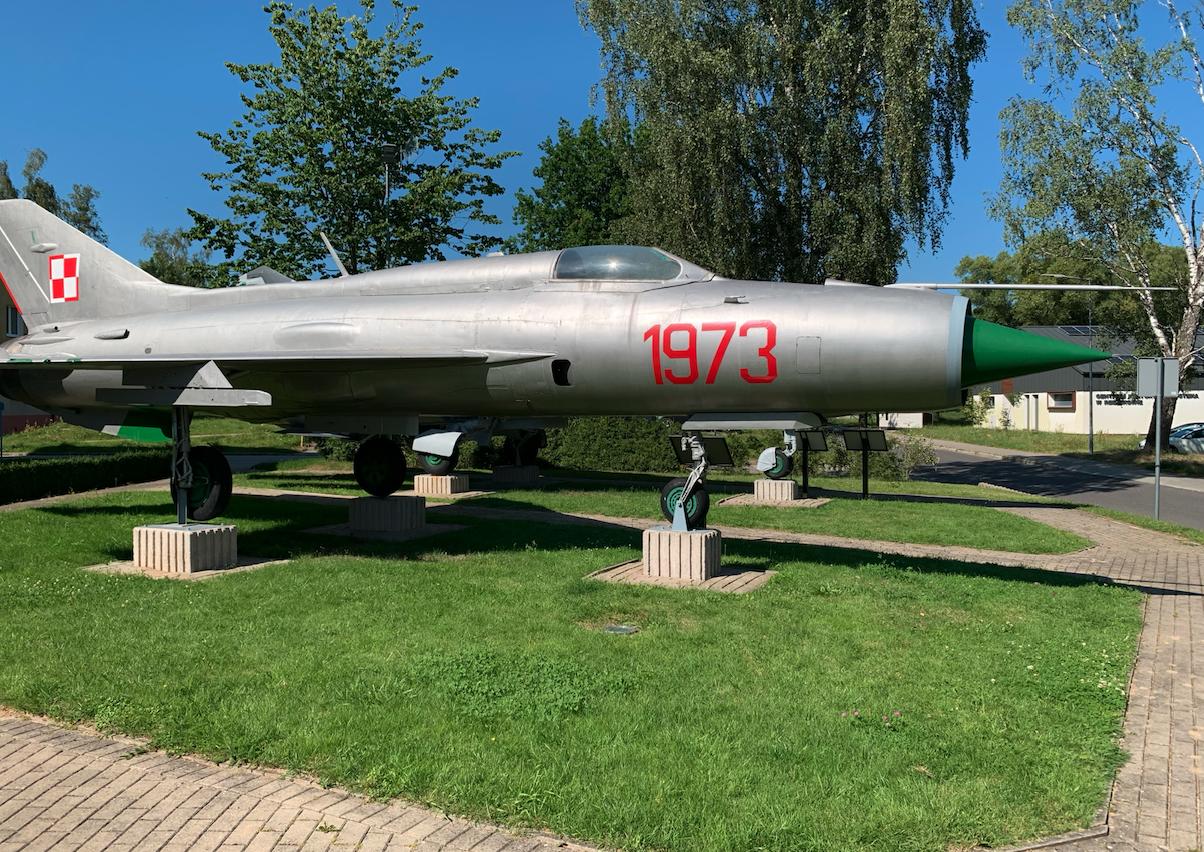Słupsk 2024-08-24
Mikojan and Guriewicz MiG-21 PF nb 1973.
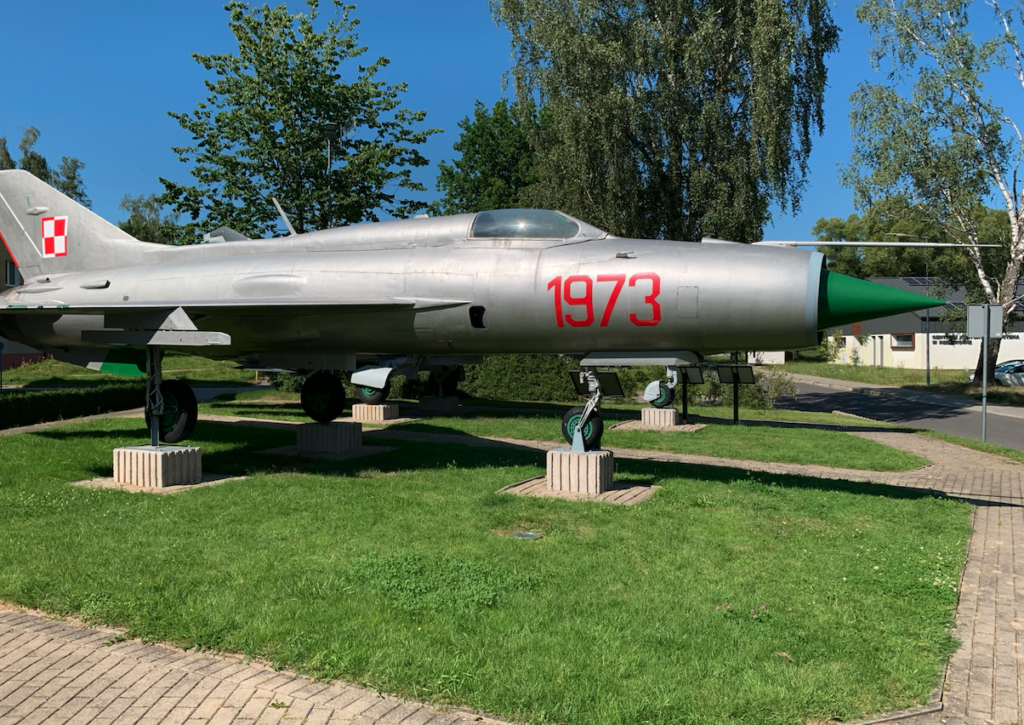
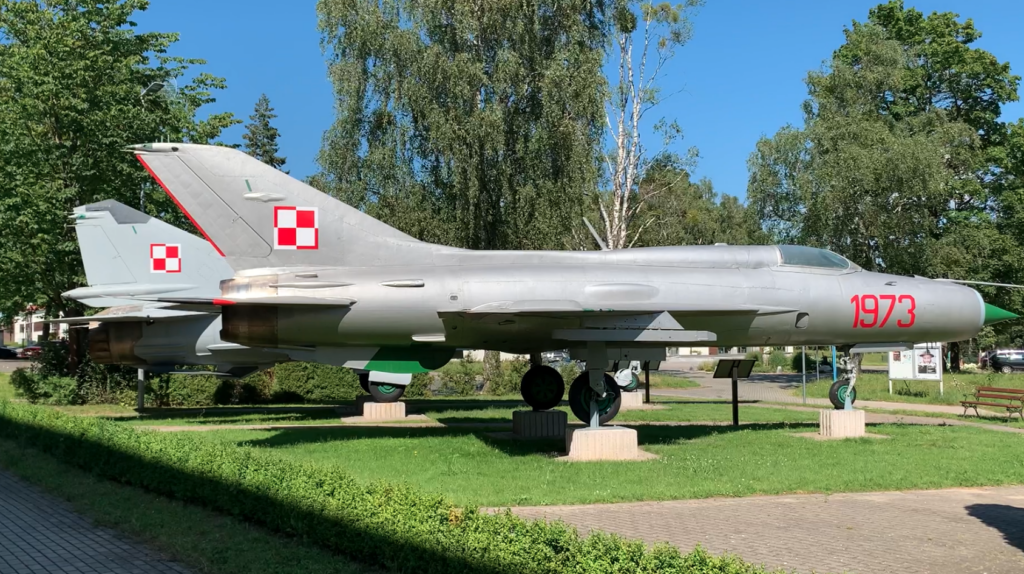
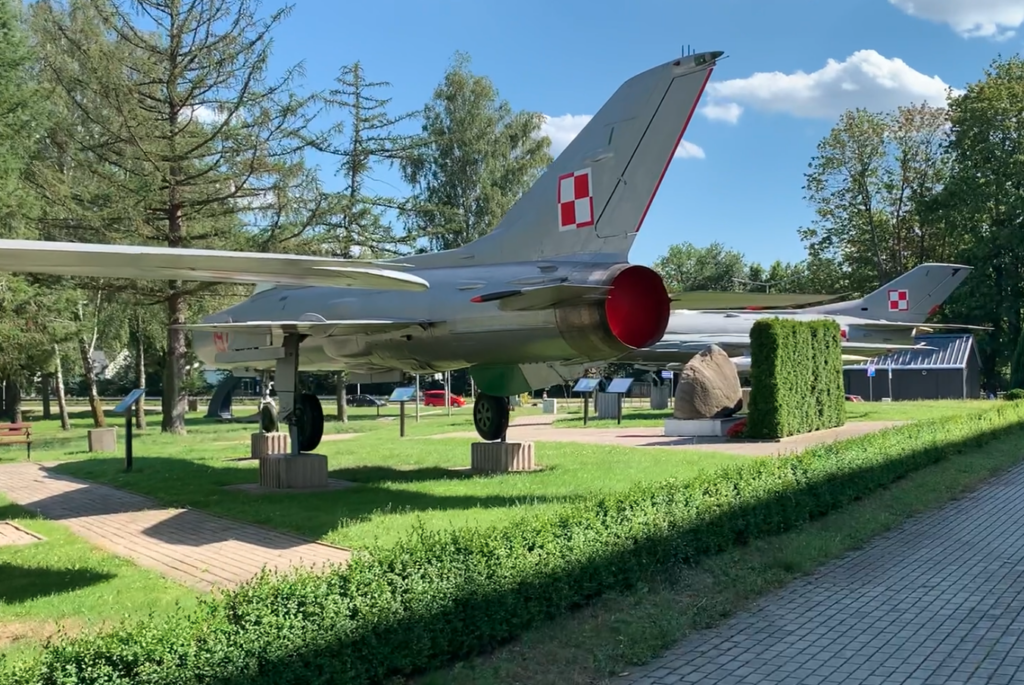
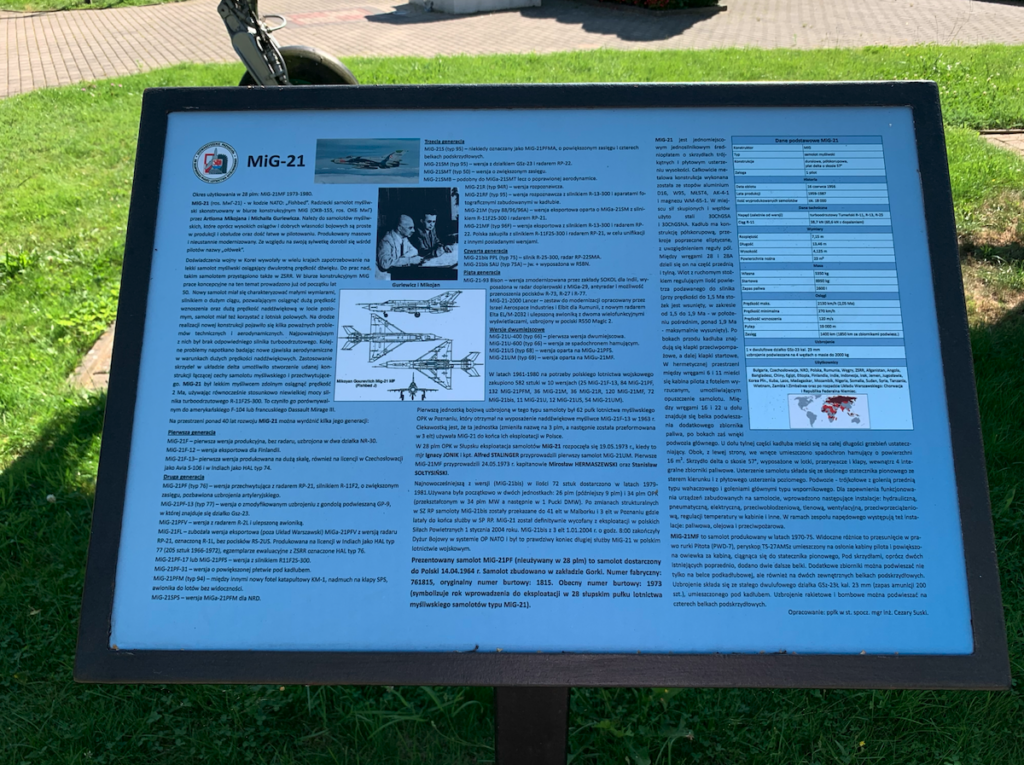
Development of the MiG-21.
During the development of the MiG-21 fighter, the requirements for the weapon system were increased. Ultimately, the front-line fighter was to have the ability to engage air targets day and night in “any weather conditions”. In this way, Mikoyan, after several years, once again gained the ability to build fighters immediately equipped with radar stations (radar sights).
MiG-21 P.
The new requirements were implemented in the E-7 prototype. The changes in design and equipment compared to the E-6 were enormous. The front part of the fuselage was enlarged to accommodate new equipment, and above all the CD-30 radar station. Its antenna was placed in an enlarged inlet cone. In order to use the radar sight better, the armament had to be changed. RS-2 U class anti-aircraft guided missiles appeared. The fighter gained the ability to cooperate with the Wozduch-1 semi-automatic ground guidance system via the Lazur radio receiver. Additionally, the equipment included; an interrogation and response device (in English IFF), KAP-1 automatic pilot and larger wheels for using ground airports. The new fighter did not mount cannons and SPO-2, RW-UM, RUM. ASP-5 N (collimator sight with rangefinder) replaced a simple sight with the PKI collimator. As for the lack of cannons, the concept of a single missile attack from the greatest possible distance and avoiding maneuver combat in accordance with the doctrine of its disappearance prevailed.
On April 9, 1959, the E-7/1 prototype was flown by pilot P. M. Ostapenko. In one of the flights, at maximum speed, (pilot I. N. Kravtsov), the aircraft lost lateral stability and the pilot ejected. The machine was lost. Tests were continued on the E-7/2 and E-7/3. Both aircraft were flown in 1960.
On May 8, 1960, the factory tests were completed and from June 1960, the factory in Gorki began serial production of the machines under the designation MiG-21 P type 76 (perekhvatchik). During the state tests, concerns were raised about the operation of the radar station and the too short range. The few machines of this type were eventually armed with K-13 guided missiles and operated under the designation MiG-21 P-13.
MiG-21 PF.
Success came only with the E-7/4 aircraft, which in August and September 1962 successfully passed factory tests and was sent for production under the designation MiG-21 PF (type 76 again). The aircraft received a CD-30 T radar station, which in production was designated RP-21 and RS-2 US missiles. Interestingly, the ability to carry K-13 guided missiles was retained. The radar station detects the bomber from a distance of 20 km, and automatic tracking starts from a distance of 11 km. The armament for attacking ground targets remained unchanged and its payload was still 500 kg.
The MiG-21 PF aircraft received a more powerful R-11 F2-300 engine with 1 x 3,870 kG thrust, with 1 x 6,000 kG afterburner. The fuel system reached a capacity of 2,780 liters by adding a seventh tank above the fuselage with a capacity of 170 liters. Additionally, the fighter received the KAP-2 autopilot ( KAP-2 K ), the front air brakes were enlarged from 0.760 m 2 to 0.884 m 2 , the probe was moved above the air intake.
The MiG-21 PF was produced in Gorki for the needs of the Red Army in 1962-1964, and for export in 1964-1966.
MiG-21 PF in Poland.
On April 14, 1964, the first MiG-21 PF models entered service with the Polish Air Force, equipped with the RP-21 radar station, RS-2 US missiles guided by a radar system, increased fuel supply, and several other novelties. These aircraft represented a completely new quality, because unlike the previous version, they could actually operate day and night, in any “any weather conditions”.
The first 4 MiG-21 PF aircraft were accepted into the 62nd PLM on April 14, 1964, and the next 2 machines on October 26, 1964. Similarly to the first version of the MiG-21 F-13, Krzesiny also became the base for transferring MiG-21 PF aircraft from the Soviet side. Since the 62nd PLM operating in Krzesiny was a combat unit, it gained the most experience in operating MiG-21 F-13 and MiG-21 PF fighters. In connection with this, the CSL (Flight Training Center) in Modlin began to lose its rank. Pilots from the 3rd PLM from Wrocław, the 13th PLM from Łęczyca, the 26th PLM from Zegrze Pomorskie, the 40th PLM from Świdwin, and the 41st PLM from Malbork were trained in Krzesiny.
By the end of 1964, 21 (other data 17) units were brought in. All fighters were placed several units in regiments, creating special duty pairs based on them. These were the following regiments; 1. PLM in Mińsk Mazowiecki, 3. PLM in Wrocław, 11. PLM in Debrzno then in Wrocław, 26. PLM in Zegrze Pomorskie and 62. PLM in Krzesiny and in CSL in Modlin.
26 PLM in Zegrze Pomorskie selected its group of pilots for retraining on MiG-21 PF in the summer of 1963, and the planes appeared in Zegrze Pomorskie in August 1964. However, the road from receiving the planes to achieving operational (combat) readiness was long. The first missile firing was not carried out until 1968.
At the beginning of 1965, MiG-21 PF fighters also began to reach the Operational Aviation regiments. Initially, the 40th PLM and 41st PLM received two machines each. In mid-1965, the 40th PLM in Świdwin received another batch of 15 MiG-21 PF aircraft no.; 761713, 761808, 761809, 761810, 761811, 761812, 761813, 761815, 761903, 761904, 761911, 761913, 762003, 762004, 762005. Such a large number of machines delivered first to this unit was caused by its participation in the WOPK on-call system on the coastal direction. Also in mid-1965, the 41st PLM received another MiG-21 PF. And so on 16.05.1965, 1 MiG-21 PF no. 761814 was added to the inventory, and on 10.07.1965, two MiG-21 PF no.; 761901, 761902.
On July 10, 1965, as part of the next delivery, the 62nd PLM received the last 5 MiG-21 PF machines. From April 1964 to October 1965, the pilots of the 1st Squadron flew both versions of the MiG-21 F-13/PF aircraft, when the MiG-21 F-13 machines were transferred to the 4th PLM in Goleniów (Air Forces). In 1966, the regiment in Krzesiny also received one MiG-21 U training and combat aircraft.
In total, Poland bought 85 (other sources indicate 84) machines. This was already a considerable number of aircraft. Deliveries were completed in 1966, or more precisely, at the beginning of 1966, the transfer of machines to the Polish Air Force was completed in Krzesiny, by CCCP.
60 aircraft were delivered to the WOPK (National Air Defense Forces), and 24 aircraft to the WL (Air Forces – Operational Aviation). The aircraft were used by the following regiments; 4th PLM in Goleniów, 10th PLM in Łask (since 1968), 39th PLM in Mierzęcice. In total, the aircraft were delivered to eleven combat regiments and to technical personnel schools in Zamość and Oleśnica.
The regiments of the 4th PLM in Goleniów and the 40th PLM in Świdnica were part of the 3rd Brandenburg Fighter Aviation Division (LO), whose name was given by Order of the Ministry of National Defense No. 55/MON of 7.10.1963. Previously, the division was called the 5th BDLM. At that time, the commander of the division was Colonel, certified pilot Wiktor Iwoń (1957-1965). The personnel of the 4th PLM in Goleniów and the 40th PLM in Świdwin began familiarizing themselves with the new aircraft as early as 1964, but the units did not receive their own aircraft until 1965. On April 1, 1965, both regiments received one squadron of MiG-21 PF fighters. The merits of these units include the first in the country to perform takeoffs and landings of MiG-21 aircraft on the DOL (road air section). The first pilot to do so was Captain Zbigniew Biedrzycki from the 4th PLM.
On March 6, 1971, in accordance with the order of the Chief of General Staff No. 012/Org., the 3rd BDLM was renamed the 3rd Brandenburg Assault Aviation Division. The tasks changed and therefore the 4th PLM in Goleniów was transferred to another division, and the 40th PLM got rid of its MiG-21 aircraft.
The 10th PLM Regiment in Łask received its first MiG-21 aircraft in 1968, when its commander was Lt. Col. Józef Radonia. The later commander of the WLOP, Lieutenant General Jerzy Gotowała, also served in this regiment. The first MiG-21 PF aircraft (6 units) for the regiment were taken over by the regiment in March 1968, from the 3rd PLM. Another 6 MiG-21 PFs were taken over in April 1968, from the 1st PLM in Mińsk Mazowiecki. Among these 12 machines were; 761506, 761608, 761610, 761614, 761708, 761712. In August 1970, another 10 MiG-21 PF aircraft were accepted. In 1971, another 7 MiG-21 PF aircraft were accepted, coming from the 13th PLM and 39th PLM. In the following years, single examples were accepted. In the period from March 1980 to October 1980, 8 MiG-21 PF aircraft were accepted from the 39th PLM. The last MiG-21 PF aircraft was accepted to the regiment on 9.03.1984.
The 10th PLM regiment said goodbye to the MiG-21 PF for good in 1989, when several aircraft were directly scrapped at the airport, and the rest were transferred to the BSP (aircraft base) in Mierzęcice.
The MiG-21 PF aircraft served in the Polish Air Force for a very long time. The last 39 units were removed from the inventory in 1989, as part of armament reduction. The MiG-21 PF was a typical representative of the missile era in aviation. It was often said that the aircraft was dying out as a means of combat, and only as a carrier of missiles. In the UK, plans to build any piloted aircraft were completely abandoned. In the USA, the F-106 fighter was to be almost completely automatic, and only take-off and landing were to be carried out by the pilot. Therefore, let’s not be surprised that the MiG-21 PF aircraft was deprived of barrel armament.
What was the MiG-21 PF attack supposed to look like in theory?
After takeoff, the pilot, still in communication with the SD (Command Station) or PN (Guidance Point), is directed to a specific course and occupies the appropriate altitude. Control is carried out visually and aurally or by instrumentation via the ARŁ-S “Lazur” radio telemetry link. The MiG-21 PF, unlike the MiG-21 F-13, already had this device. Only when the aircraft is at the appropriate distance from the enemy, does it activate SR, intercept the target, perform the attack and return to base. The attack was supposed to be a single attack. In combat conditions, the distance was several kilometers. In training flights, about 20 km.
We know that this scheme did not stand the test of time, which was confirmed by subsequent armed conflicts. Therefore, even in the 80s, despite losing many of its combat properties, the MiG-21 PF could be an effective weapon. With good organization of the fight, taking into account all the limitations of the aircraft, it was possible to fight effectively with it. Good tactics, i.e. using demonstration groups at high altitudes with SR turned on, simulation groups pretending, for example, to attack ground targets, strike groups operating at low altitude, hidden against the background of the ground ready to attack, changes in the composition of groups, withdrawal of aircraft with a small fuel supply. The effectiveness of operations would increase with the use of the DRŁO system, an equivalent of AWACS, which Poland did not have, but CCCP did not have in service either.
In Poland, shooting at air targets, usually in the form of luminous bombs, was carried out at the Ustka training ground. Real launching (shooting) of k.p.r. missiles at flying targets, maneuvering and non-maneuvering, on MiG-21 PF aircraft was not carried out in Poland. These exercises were carried out at the CCCP, at a training ground located beyond the Caspian Sea. These exercises were carried out no more than once a year, due to high costs. A selected group of pilots, guidance navigators, communication specialists, a radio engineering group for flight insurance and armament technicians, after successfully completing exercises at the Ustka training ground, went to the CCCP by transport aircraft. There was always a group of officers from the Air Force Command (DWL) and the Command of the training division. Only Russian equipment was used. After familiarizing themselves with the equipment, the exercises began. It started with fighting a non-maneuvering target, then the target maneuvered, and finally tactical elements were introduced, i.e. approximation to war conditions. The air target was usually the La-17 in various versions, e.g. MM.
Unilateral arms reduction.
Along with the political changes in Poland at the turn of 1989-1990, the authorities decided to relieve the country’s budget and relieve society, among other things by reducing spending on arms. One of the elements of such a policy was the unilateral arms reduction. It consisted of withdrawing from service several dozen MiG-21 PF combat aircraft. To show that this was being done, in the 10th PLM in Łask, several aircraft were dismantled along with cameras and cameras. On January 15, 1990, MiG-21 PF aircraft no. 760610, 760702, 762006 were definitely scrapped.
Written by Karol Placha Hetman

